The Pink Pigeon (Nesoenas mayeri) stands as a symbol of resilience and conservation on the island of Mauritius.
Endemic to this tropical paradise, the Pink Pigeon captivates with its delicate pink plumage, elegant crest, and captivating presence.
Once on the brink of extinction due to habitat loss and predation, this iconic bird has become a flagship species for conservation efforts in Mauritius.
Through dedicated conservation initiatives, including captive breeding programs, habitat restoration, and predator control measures, the Pink Pigeon’s population has experienced a remarkable recovery.
Today, it is a testament to the power of collaborative conservation action and the importance of protecting endangered species and their habitats.
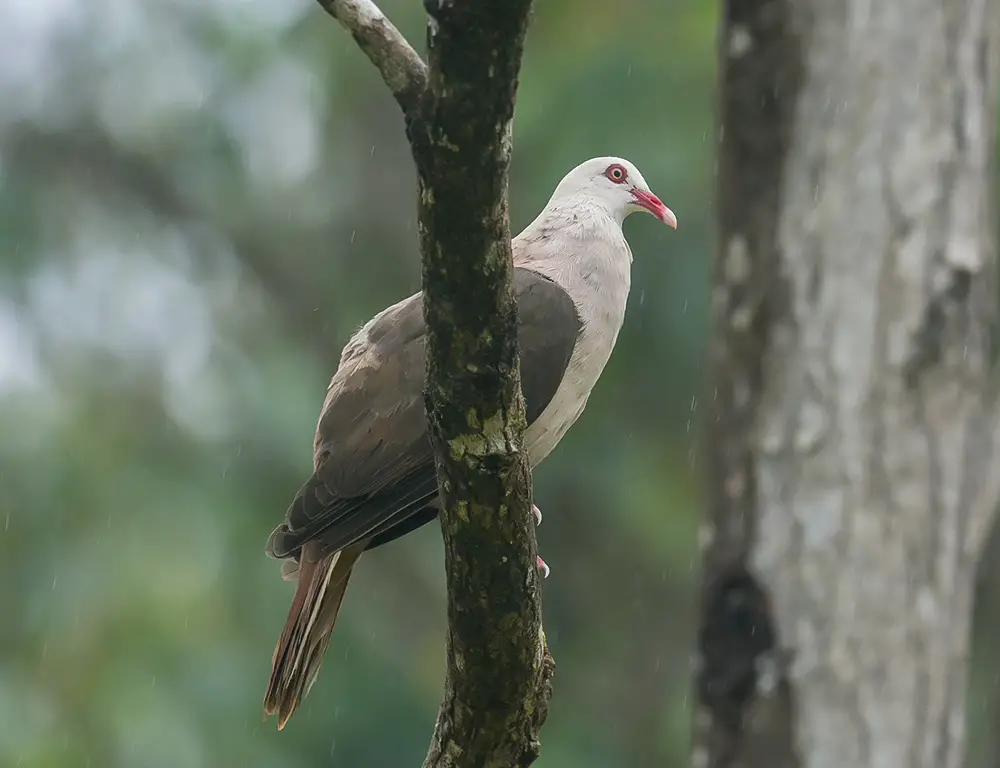
Some Characteristics Of Pink Pigeons
The Pink Pigeon (Nesoenas mayeri) is a unique bird species native to Mauritius, known for its distinctive pink plumage and conservation significance. Here are some common characteristics of the Pink Pigeon:
Physical Characteristics
The Pink Pigeon (Nesoenas mayeri) is a remarkable bird endemic to Mauritius, renowned for its striking appearance and unique physical traits. Here are seven key physical characteristics that distinguish this species:
Plumage
The Pink Pigeon boasts a delicate blend of soft pink and gray feathers adorning its body. Its plumage exhibits subtle variations in hue, with males typically displaying brighter pink tones than females.
This distinctive coloration serves as camouflage in its forest habitat and as a visual cue during courtship displays.
Size
Compared to other pigeon species, the Pink Pigeon is relatively large, measuring around 30 to 34 centimeters in length. Its robust build and sturdy legs enable it to forage and navigate its dense woodland environment with agility and precision.
Crest
One of the most striking features of the Pink Pigeon is its elegant crest, which adorns the top of its head. This crest consists of a tuft of elongated feathers that can be raised or lowered, adding to the bird’s overall aesthetic appeal and enhancing its presence.
Beak
The Pink Pigeon possesses a stout, hooked beak perfectly adapted for its omnivorous diet. This powerful beak enables it to crack open tough seeds and nuts and feed on various fruits, berries, and insects in its habitat.
Eye Color
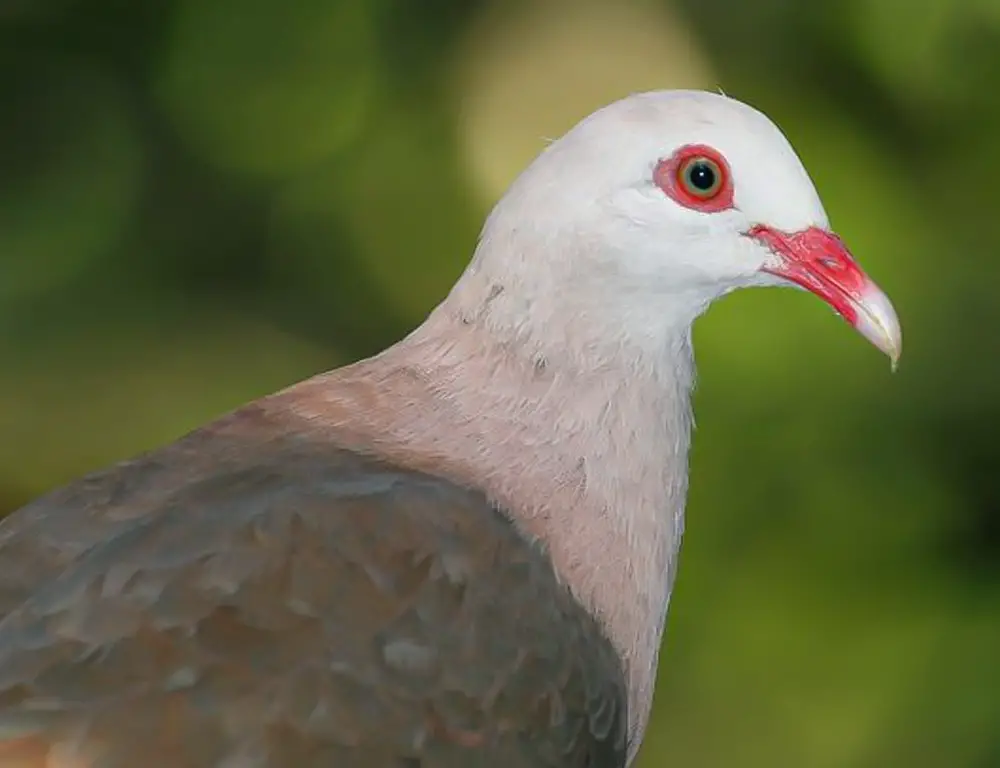
A notable physical characteristic of the Pink Pigeon is its vibrant red eyes, which stand out against the soft pink feathers of its face. These striking eyes add to the bird’s captivating appearance and overall allure.
Wing Pattern
While the Pink Pigeon’s plumage is predominantly pink and gray, its wings feature intricate patterns of darker gray or black feathers. These patterns provide additional camouflage when the bird is in flight and add visual interest to its overall appearance.
Tail Feathers
The Pink Pigeon’s tail feathers are relatively short compared to other pigeon species, giving it a sleek and streamlined silhouette. Despite their modest length, these tail feathers play a crucial role in stabilizing the bird during flight and maneuvering through dense vegetation.
Distribution And Habitat
Pink Pigeons are endemic to the forests of Mauritius, where they inhabit mountainous regions and dense vegetation. Habitat loss and fragmentation have restricted their range, making them highly localized within protected areas.
Reproduction
Pink Pigeons typically breed during the warmer months, constructing nests in trees or shrubs. They lay one or two eggs per clutch, which both parents incubate. Breeding success is crucial for the species’ survival due to its endangered status.
Lifespan/Longevity
Pink Pigeons have a relatively long lifespan compared to other pigeon species, with individuals capable of living up to 20 years or more in the wild under favorable conditions.
Communication And Perception
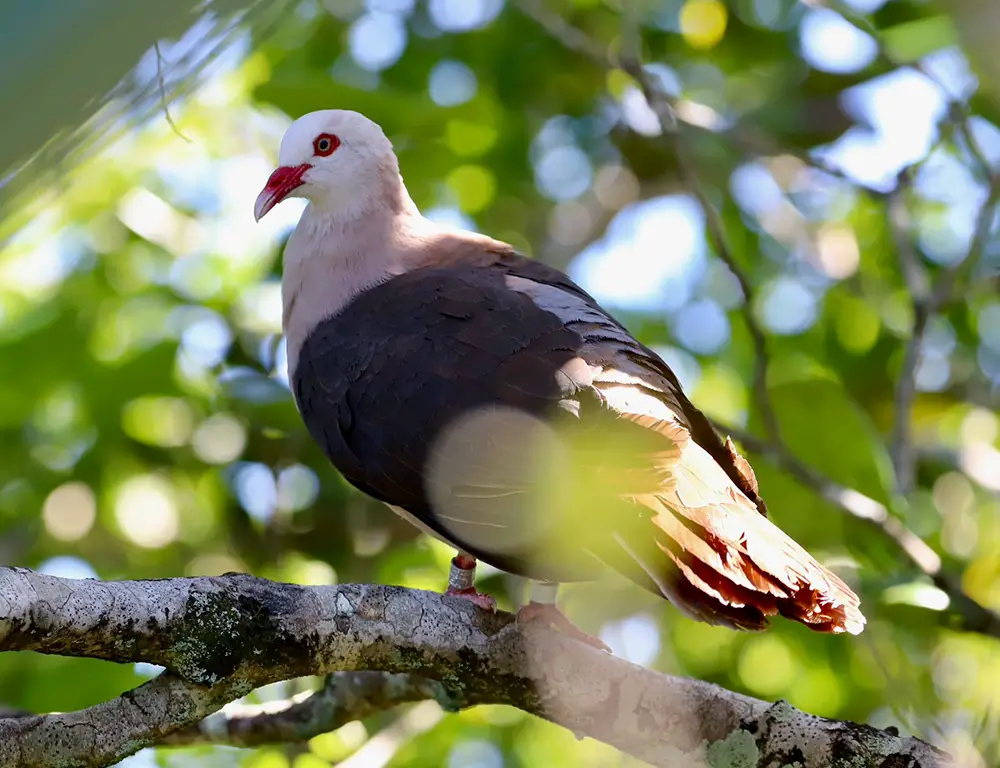
Pink Pigeons use vocalizations, body language, and visual cues to communicate with conspecifics and assess their environment. Their keen perception helps them navigate their forest habitat and detect potential threats.
Status
Pink Pigeons are classified as endangered by the IUCN Red List, with a population of fewer than 500 individuals in the wild. Conservation efforts, including captive breeding programs and habitat restoration, are underway to prevent their extinction.
Food Habits
Pink Pigeons primarily feed on a diet of fruits, seeds, and foliage in their forest habitat. They play a role in seed dispersal, contributing to the regeneration of native plant species.
Conservation
Conservation efforts for the Pink Pigeon focus on protecting its remaining habitat, controlling invasive species, and breeding individuals in captivity for release into the wild. These efforts aim to stabilize and increase the wild population.
Taxonomy
Below is the table of taxonomy for the Pink Pigeon:
| Taxonomy Level | Classification |
| Kingdom | Animalia |
| Phylum | Chordata |
| Class | Aves |
| Order | Columbiformes |
| Family | Columbidae |
| Genus | Nesoenas |
| Species | Nesoenas mayeri |
This table outlines the taxonomic classification of the Pink Pigeon, from the broadest category (Kingdom) to the most specific (Species).
Nesting Habit
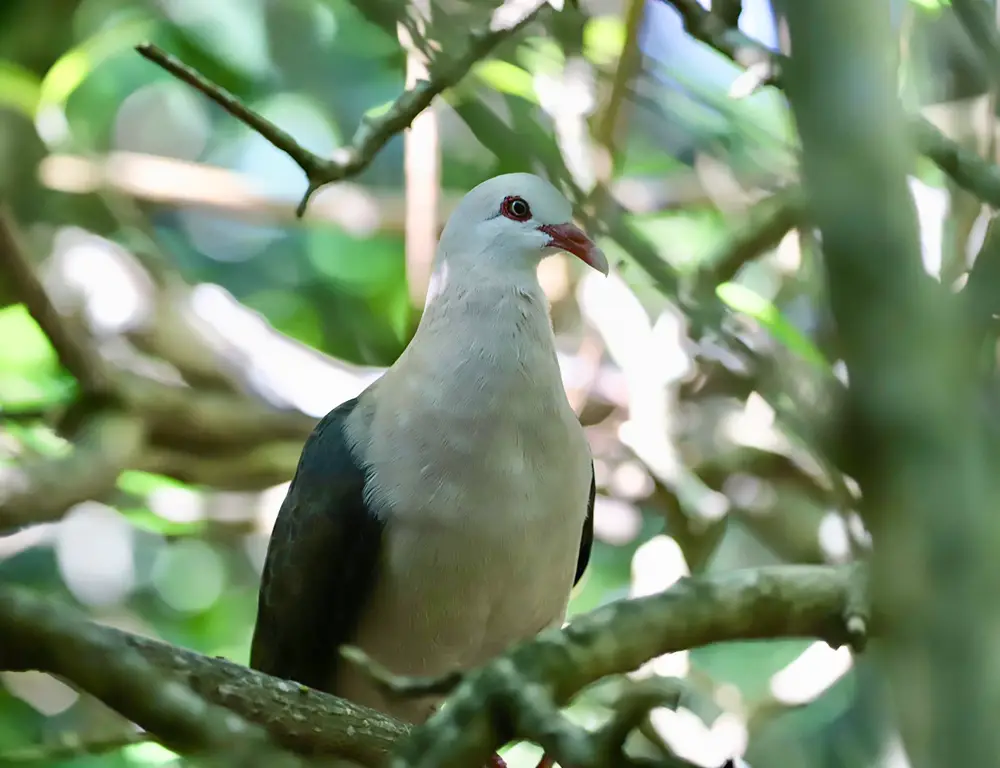
Here’s a table outlining the nesting habits of the Pink Pigeon:
| Nesting Habit | Description |
| Nest Location | Tree cavities or artificial nest boxes, often in dense forest areas |
| Nest Materials | Twigs, leaves, and other plant materials |
| Nest Construction | Both male and female pigeons participate in nest-building activities |
| Breeding Season | Typically occurs from November to April, corresponding with the austral summer. |
| Clutch Size | Usually lays 1-2 eggs per clutch, occasionally 3 |
| Incubation Period | Both parents share incubation duties, lasting around 16-19 days |
| Chick Rearing | Both parents feed and care for the chicks until they fledge |
This table provides an overview of the nesting behavior and habits of the Pink Pigeon, including where they nest, the materials they use, and their breeding season characteristics.
Threats
Habitat loss, predation by introduced species, and resource competition threaten the Pink Pigeon’s survival. Invasive predators such as rats and feral cats target adults and nests, exacerbating population decline.
In Culture
The Pink Pigeon holds cultural significance in Mauritius, where it is celebrated as a symbol of the island’s unique biodiversity. Its plight has inspired conservation awareness and initiatives among local communities and international organizations.
Behavior And Ecology
Pink Pigeons exhibit social behavior, often forming monogamous pairs and small family groups. They play a vital role in the ecosystem as seed dispersers, helping maintain the health and diversity of Mauritius’ native forests.
These characteristics highlight the importance of the pink pigeon as a flagship species for conservation and underscore the urgent need to protect its habitat and ensure its survival for future generations.
Ranging Map
The ranging map of the Pink Pigeon (Nesoenas mayeri) provides a visual representation of the species’ distribution and habitat utilization within its native range on the island of Mauritius.
Typically, the ranging map depicts the distribution of Pink Pigeon populations across Mauritius, highlighting key habitats such as dense forests, wooded areas, and montane regions.
These habitats provide the necessary resources for nesting, foraging, and roosting, and the map may indicate the specific locations where Pink Pigeons are known to frequent.
How Rare Are Pink Pigeons?
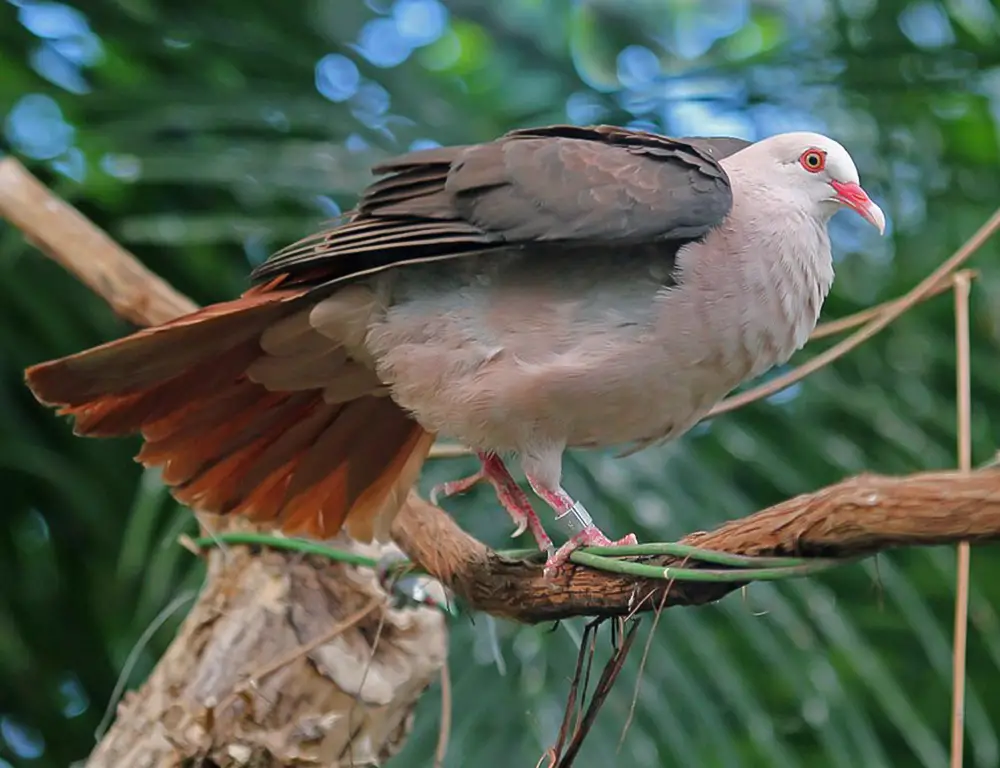
Pink Pigeons (Nesoenas mayeri) are rare due to their restricted range and small population size. Here are some situations highlighting their rarity:
Endemic Species
Pink Pigeons are endemic to Mauritius, meaning they are found nowhere else. This limited geographical range contributes to their rarity, as they are confined to a relatively small habitat area.
Small Population Size
The population of Pink Pigeons is relatively small, with estimates suggesting only a few hundred individuals remain in the wild. This low population size makes them vulnerable to habitat loss, predation, and disease threats.
Historical Decline
Pink Pigeons have experienced a significant decline in population numbers over the past few centuries, primarily due to habitat destruction, hunting, and predation by introduced species. This historical decline has further contributed to their rarity today.
Endangered Status
Pink Pigeons are classified as Endangered on the IUCN Red List, indicating that they face a high risk of extinction in the wild. This official designation underscores the urgent need for conservation efforts to protect and restore their populations.
Limited Habitat
Pink Pigeons primarily inhabit dense forests and wooded areas in Mauritius, significantly reduced and fragmented due to human activities such as logging, agriculture, and urbanization. The loss of suitable habitat further exacerbates their rarity.
Specialized Diet
Pink Pigeons have specific dietary requirements, feeding primarily on native plant species in their forest habitat. Their reliance on specific food sources makes them susceptible to habitat availability and quality changes, contributing to their rarity.
Conservation Dependency
Pink Pigeons depend heavily on ongoing conservation efforts for their survival. Captive breeding programs, habitat restoration initiatives, and predator control measures are essential for mitigating threats and increasing population numbers.
Without continued conservation intervention, their rarity may persist or worsen over time.
Pink Pigeons are rare birds facing numerous threats to their survival. Their limited range, small population size, historical decline, and dependence on conservation efforts highlight the importance of ongoing conservation actions to ensure their continued existence in the wild.
Conclusion
The Pink Pigeon’s journey from the brink of extinction to a symbol of hope and resilience underscores the importance of proactive conservation efforts.
Through the dedication of scientists, conservationists, and local communities, the Pink Pigeon has been given a second chance at survival. However, its continued existence in the wild remains dependent on ongoing conservation actions.
By preserving its habitat, controlling invasive species, and raising awareness about its conservation needs, we can ensure that future generations can admire the beauty of the Pink Pigeon and appreciate its vital role in Mauritius’ natural heritage.